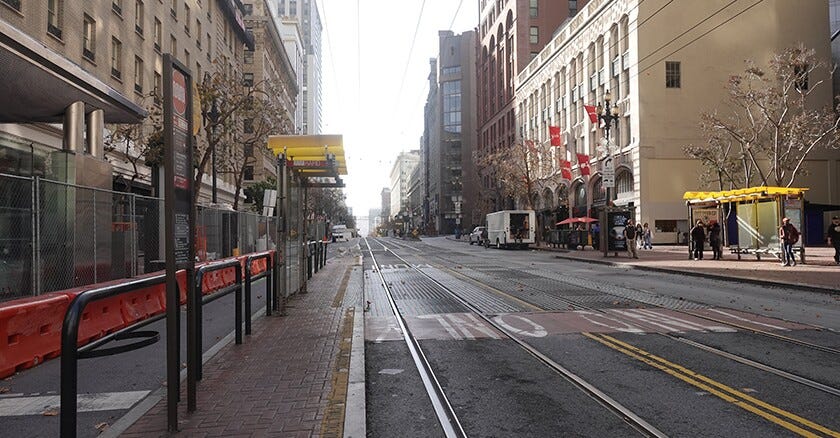The question is not how to get people back to the office workplace. The question is what do office-based workers need to thrive.
Maybe people who type all day for a living need something more than sitting in the extra bedroom, joining the occasional zoom call, and picking up the kids.
Hello everybody — all my recent ranting about how to revive Dead Malls led me to write an op-ed in the San Francisco Chronicle about the challenge of one of the biggest Dead Malls in the country — San Francisco Centre on Market Street in Downtown San Francisco. The link is here, though it may be behind a paywall.
In order for me to afford to continue bringing you Future Of Where’s great content, I rely on my paying subscribers. So consider becoming a free or paid subscriber — and help extend our reach by restacking or sending this post along to other folks.
Urban planners tend to think of cities as physical places – “built environments,” as well call them, with houses where people live, stores where they shop, offices and factories where they work, and so on. Our job, at least as we usually envision it, is to create the best possible built environment where people can thrive.
But as we’ve learned since the pandemic, that’s not really why cities exist. If you think about the history of cities – like I used to do when I taught a class called “The Evolving City” – you think a lot the economic functions of a city. Because with some exceptions – seats of government being one of them – cities exist not so people can thrive but so they can make money.
The New York City subway around 1950 — at the height of the “I must be near my paper” economy.
The oldest function of a city, as I always taught my students, is to serve as a marketplace. It’s where people bring goods (and, these days, services) in order to trade with each other. (And, by the way, market cities are still often the richest ones, because of the tremendous value that a transaction creates on both sides.)
Other functions only came later. First came skilled artisans – making tools, for example – along with some people we might today call accountants, who kept track of things. Then the industrial age blew out the skilled artisans with mass production, starting around the end of the 18th Century, when steam energy made that possible.
And once you had mass production, there was a lot more to keep track of. And so the number of accountants – the paper-pushers, the bureaucrats – exploded in number. This happened around the end of the 19th Century.
Which, by the way, was just about the time large retail emporiums came into existence.
And, therefore, when large downtowns emerged.
This is hard to remember nowadays, but the original downtown – the late 19th Century and early 20th Century downtown – was all about centralized office and retail functions. Mining, manufacturing, and other production functions were located all over the place – often near the source of raw material or transportation routes or, as today, on the edge of town.
But downtowns came about because retail and office functions were centralized. Shoppers had to be near the stuff they bought if they wanted to see it and feel it. (Otherwise they were reliant on the Sears catalogue.) And in the pre-computer age, all those accountants and paper-pushers had to be near their paper – and their paper had to be in one central location.
Now we’re seeing both centralized functions blow apart. Retail is moving online, though not as fast as you might think. (Almost 80% of retail sales still take place in person, mostly in the suburbs – and that doesn’t include bars and restaurants or auto dealers.) Office workplaces, however, are collapsing as remote work has become a permanent part of the landscape. To use the most obvious (and dystopian) example, Downtown San Francisco saw office vacancy rates rise from 5% pre-pandemic to 30% in 2024, while the actual occupancy of leased space in 2025 was only 44%, and the office buildings themselves have lost 70-80% of their value since the beginning of the pandemic.
Market Street in San Francisco is still pretty dead.
This is a problem for downtowns and “Edge Cities” – The Galleria, Century City, Tysons Corners – because these dense districts have built themselves around the idea that lots of office workers commute in to them every day, occupy office space, and drop a fair amount of money while they are there.
And so the battle cry for cities has been, “How do we get office workers back to the office?”
But my interview the other day with workplace investment expert Lisa Picard suggests to me that that’s looking through the wrong end of the telescope.
The question is not how to get people back to the office workplace.
The question is what do office-based workers need to thrive.
So here are four ideas that cities and employers can work together on to see how to align cities’ focus on prosperous places (sorry, I just can’t get away from Place And Prosperity!) with office-based employers focus on maximum productivity from employees.
PAYWALL





